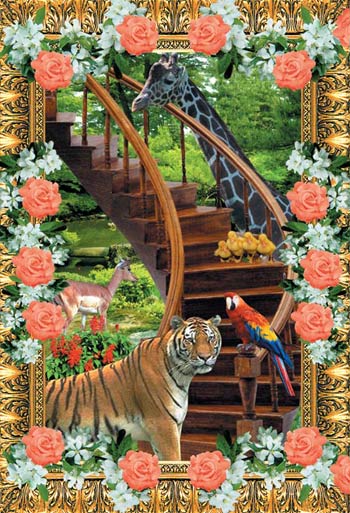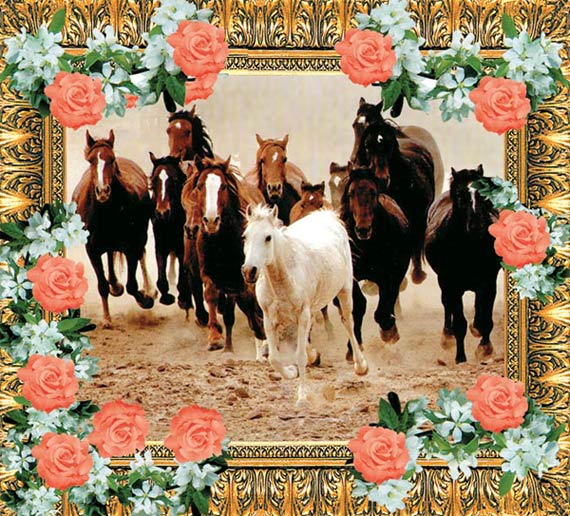
When you observe this Earth we live on, you see that it is a wondrous place that meets all your needs in the most perfect way. The bread, cheese, honey, meat, fruits and vegetables you eat with their many different flavors; the water, milk and fruit juices you drink; the air you breathe; your furniture and other objects crafted of wood and glass and plastic; the articles of clothing you wear; fossil fuels such as gasoline, coal and natural gas that provide your heating, transport and all kinds of energy requirements; the cats, dogs, trees and flowers you see when you are out walking; the medicines and remedies you take when you are ill; animals and plants with their totally different structures and features, the dazzling colors and perfect systems that you see on the television; butterflies, birds and fish; all matchless works of art; insects living in unspoiled forests and unexplored regions that you see photographed in magazines and newspapers; roses, lilacs, orchids, lavenders and violets, with their stunning perfumes and appearances; even this page that you are reading at the moment...
At first, you may not see any connection between all these objects, but take a second look. You will then realize that all living things—as well as man's handiwork— are the result of a glorious variety on Earth. The millions of species of living animals, plants and members of the other three kingdoms (fungi, Protista and Monera) that exist mostly at the microscopic level, constitute an ideal environment for all of your human needs to be met.
The Earth hosts millions of living species, from bacteria and viruses too small to be seen with the naked eye to giant Sequoias, from minuscule beetles and midges to enormous whales. Some 2 million different living species have been identified to date, although it is estimated that there are actually many more. There is practically no place on Earth that is completely devoid of life. Wherever you may go, from thousands of meters beneath the sea surface to the highest mountain peaks, from the burning deserts to the icy poles, you will encounter a variety of living species. The many different environments on Earth offer very different conditions: Oceans, seas, lakes, rivers, coral reefs, marshes, forests, meadows, deserts, rocky outcrops... No matter how different their conditions may be, all play host to a wide range of life forms.
Everyone knows that our a planet contains a teeming variety of life. Yet most people may never have reflected on this astonishing state of affairs, nor considered the great importance of this variety and how it must have come into being. They may never have thought of the need to reflect on these things. Now, putting aside for a moment the perspective stemming from familiarity, try to imagine a world without all these living things you know about.

First, picture an Earth in which there are no terrestrial or marine plants, no forests, and no trees. You will soon come to an obvious conclusion: Were it not for plants that perform photosynthesis every day, the oxygen essential for life would not be replenished, and for that reason, there would be no life on Earth apart from a few bacteria.
And what would the world be like without bacteria, whose species are estimated to number between 300,000 and 1 million, most of whose scientific names are known only to experts? Yet even if we have very little knowledge about bacteria, members of a different world that we cannot see, there is still one indisputable fact: Life without them is inconceivable. Because the production of a large part of the oxygen in the atmosphere, its elemental cycles, the cleansing of the Earth and the breakdown of dead organisms into re-usable substances and many other vital processes are all due to these microscopic creatures.
Vertebrates, mollusks, arthropods, crustaceans and dozens of other plant and animal groups play an important role in the ecological balance in the seas, forests and land. Were any of these to be absent, the processing of dead organisms into new sources of food would be interrupted, the soil would become unproductive, the food chain would be damaged. Habitats would disappear and as a result, all animals, plants and humans would disappear from the face of the Earth.
We could cite more examples, but the lesson is always the same: Humanity could not survive in the absence of other living things. Plants, animals, fungi and bacteria—in short, all the millions of living species—are at the service of human beings. In the face of this miraculous state of affairs, a number of questions spring to mind:
How did the unimaginable variety of life on Earth come into being?
How did these living things that enchant our souls with their matchless beauty and meet all our needs with the characteristics they possess, come into existence?
How do these millions of living species live in such perfect harmony with their surroundings and with one another?
To whom do the flawless features in each and every species—estimated to number around 100 million—actually belong?
Evolutionists seek to answer these questions, and account for the origin and variety of life, by means of the theory of evolution. They claim that life came into being from inanimate substances, by chance and over the course of time; and that the variety of life in some way arose from single-celled organisms, as the result of natural phenomena and random factors. Many evolutionists have supported these claims ever since Charles Darwin first published his theory, and have offered so-called proofs with which to back them up. However, scientific discoveries have refuted the theory of evolution time and again.
There are innumerable questions to which Darwinism is unable to provide any rational and scientific answers. One of the greatest problems facing evolution is the extraordinary variety of living things, and the origin of these species on Earth. The realization that there are insuperable genetic barriers between species, the sudden emergence of life forms in the fossil record, and the fact that living things possess organs and systems that are wondrous marvels of design unmatched by even the most advanced 21st century technological progress, have all demolished evolutionist claims.
Rather than admitting their mistakes, most evolutionists have tried to salvage the situation by means of imaginary fairy-tale scenarios. Yet evolutionists have no answer to the question of speciation, which Charles Darwin described as the "mystery of mysteries" 1 and to which he long sought an answer. And that despite the intervening 150 years and all their intense efforts!
On the other hand, anyone looking in a sincere, unprejudiced way can clearly see that we live in a miraculous environment. Those bacteria, animals and plants that give rise to such ideal conditions cannot have come into being by chance. The fact is, every species on Earth is the product of a sublime creation. From their proteins and cells to their organs and systems, they carry messages that reveal the glory of their creation. Every living species points to the existence of an Almighty, Omniscient Creator possessed of an infinite artistry and intelligence. That Creator is God, Lord of the worlds.

The fact that God has created all living things and placed them at the disposal of man is revealed in the Qur'an. Some verses in Surat an-Nahl refer to this:
He created the heavens and the Earth with truth.
He is exalted above anything they associate with Him.
He created man from a drop of sperm and yet He is an open challenger! And He created livestock.
There is warmth for you in them, and various uses and some you eat.
And there is beauty in them for you in the evening when you bring them home and in the morning when you drive them out to graze.
They carry your loads to lands you would never reach except with great difficulty.
Your Lord is All-Gentle, Most Merciful.
And horses, mules and donkeys both to ride and for adornment.
And He creates other things you do not know.
The Way should lead to God, but there are those who deviate from it.
If He had wished He could have guided every one of you.
It is He Who sends down water from the sky.
From it you drink and from it come the shrubs among which you graze your herds.
And by it He makes crops grow for you and olives and dates and grapes and fruit of every kind.
There is certainly a Sign in that for people who reflect.
He has made night and day subservient to you, and the sun and moon and stars, all subject to His command.
There are certainly Signs in that for people who use their intellect.
And also the things of varying colors He has created for you in the Earth.
There is certainly a Sign in that for people who pay heed.
It is He Who made the sea subservient to you so that you can eat fresh flesh from it and bring out from it ornaments to wear.
And you see the ships cleaving through it so that you can seek His bounty, and so that hopefully you will show thanks.
He cast firmly embedded mountains on the Earth so it would not move under you, and rivers and pathways so that hopefully you would be guided, and landmarks.
And they are guided by the stars.
Is He Who creates like Him who does not create? So will you not pay heed?
If you tried to number God's blessings, you could never count them.
God is Ever-Forgiving, Most Merciful. (Surat an-Nahl, 3-18)
Obviously the variety of life is a very considerable subject to be dealt with in a single volume. This book describes the general outlines of that variety and what it provides us with. It recalls some of the blessings too many to be listed, even in general terms. In addition, it sets out some of the verses about living things, and indications of the existence and attributes of God, as described in Qur'an:
And in your creation and all the creatures He has spread about there are Signs for people with certainty. (Surat al-Jathiyya, 4)
One aim of this book is to show how irrational and unscientific are evolutionist claims concerning the richness of life, and to invalidate such Darwinist concepts as speciation and macro-evolution. Separate chapters are devoted to the Galapagos finches and industrial melanism, which evolutionists portrayed as fundamental proofs at every opportunity. Scientific facts describe how these tales constitute no evidence of evolution at all.
1 C. Darwin, The Voyage of the Beagle, New York: Penguin Books, 1988, p. 326.